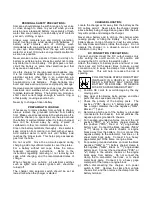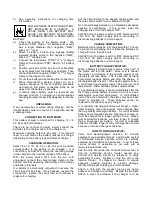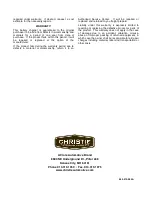
PERSONAL SAFETY PRECAUTIONS:
Someone should always be within range of your voice
or close enough to come to your aid when you are
working near a lead-acid battery. Have plenty of fresh
water and soap nearby in case battery acid contacts
your skin, clothing, or eyes.
Always wear complete eye and clothing protection.
Avoid touching eyes while working with batteries. If
battery acid contacts skin or clothing, wash
immediately with soap and plenty of water. If acid gets
in your eye, immediately flood the eye with running
water for at least 10 minutes and get medical attention
as soon as possible.
Never smoke or allow a spark or flame in vicinity of a
battery or vehicle engine. Be extra careful not to drop
any metal tool onto a battery. It might spark or short-
circuit the battery or some other electrical part that
may cause an explosion.
Use this charger for charging lead-acid batteries only.
It is not intended to supply power to any low voltage
electrical system other than in an automotive ap-
plication. Do not use this charger on common
household dry cell batteries. These batteries may
burst and cause serious injuries and property damage.
Remove personal metal items such as rings, bracelets,
necklaces and watches when working with an au-
tomotive lead acid battery. The battery can produce a
short circuit current large enough to weld a ring or
other jewelry, causing a severe burn.
Never try to charge a frozen battery.
PREPARING TO CHARGE:
If necessary to remove battery from vehicle to charge,
always remove the grounded terminal from battery
first. Make sure all accessories in the vehicle are off to
avoid the chance of a spark. Be sure the area around
the battery is well ventilated while it is being charged.
Gas can be fanned away by using a piece of
cardboard or other non-metallic material as a fan.
Clean the battery terminals thoroughly. Be careful to
keep corrosion from coming in contact with your eyes.
Add distilled water in each cell until battery acid
reaches the proper level. This helps purge excessive
gas from the cells.
Do not overfill. Since the acid will expand during
charging, add only sufficient water to cover the plates.
For a battery without cell caps, follow the manu-
facturer's recharging instructions. Refer to the
instructions regarding removing or not removing cell
caps while charging, and the recommended rates of
charge.
When charging in a vehicle, all electrical switches
such as lights, radio, heater, ignition, etc., should be
turned off.
The charger rate selector switch should be set at
lowest rate when the charger is started.
CHARGER LOCATION:
Locate the charger as far away from the battery as the
DC cables permit. Never place the charger directly
above battery being charged since gases from the bat-
tery will corrode and damage the charger.
Never allow battery acid to drip on the charger when
reading gravity or filling the battery. Do not set a
battery above, on top of charger or next to vents where
fan may draw acid fumes inside the charger. Do not
operate the charger in a closed-in area or restrict
ventilation in any way.
DC CONNECTION PRECAUTIONS:
Connect and disconnect the DC output clamps only
after setting the on/off switch to off position and
removing the AC cord from the electric outlet.
Attach the clamps to battery posts and twist or rock
them back and forth several times to make a good
connection and to keep the clamps from slipping off
the terminals. This will help to reduce the risk of
sparking.
FOLLOW
THESE
STEPS
FOR
BATTERY
INSTALLED
IN
A
VEHICLE.
A
SPARK
NEAR
A
BATTERY
MAY
CAUSE
THE
BATTERY
TO
EXPLODE.
TO
REDUCE
RISK
OF
A
SPARK
NEAR
BATTERY:
a)
Position DC cords to avoid damage by the any
moving parts.
b)
Stay clear of fan blades, belts, pulleys, and other
parts that can cause personal injury.
c)
Check the polarity of the battery posts. The
positive ("POS", Red or "
+
") battery post usually
has a larger diameter than the negative ("NEG",
Black or "
-
") post.
d)
Determine which post of the battery is grounded
(connected to the chassis). In most vehicles, the
negative post is grounded to chassis.
e)
For negative-grounded vehicles, connect the red
positive ("POS", or "
+
") battery charger clamp to
the positive ("POS", Red or "
+
") ungrounded
battery post. Connect the black negative ("NEG"
or "
-
") clamp to the vehicle chassis or engine
block away from the battery. Do not connect the
negative clamp to the carburetor, fuel lines, or to
sheet metal body parts. Connect it to a heavy
gage metal part of the frame or engine block.
f)
For positive grounded vehicles, connect the black
negative ("NEG" or "
-
") battery charger clamp to
the negative ("NEG", Black or "
-
") ungrounded
battery post. Connect the red positive ("POS", or
"
+
") clamp to the vehicle chassis or the engine
block away from battery. Do not connect the
clamp the to carburetor, fuel lines, or to sheet
metal body parts. Connect it to a heavy gage
metal part of the frame or engine block.
g)
When disconnecting the charger, turn power
switch to OFF. Remove the clamp from vehicle
chassis first, and then remove the clamp from the
battery terminal.




